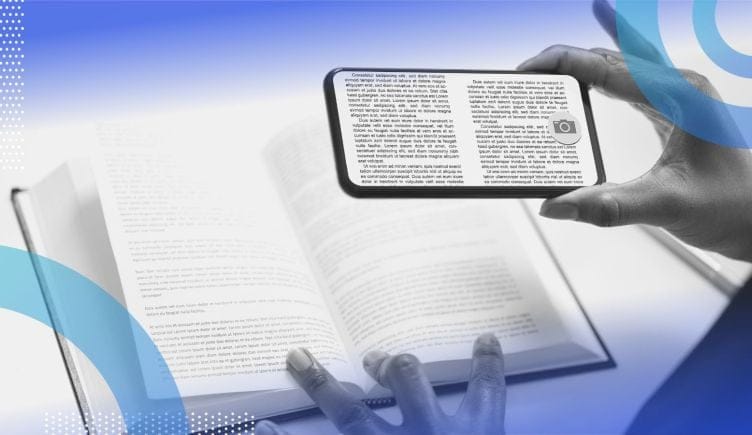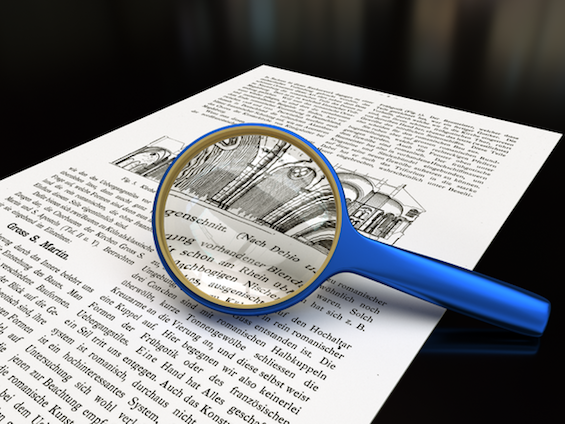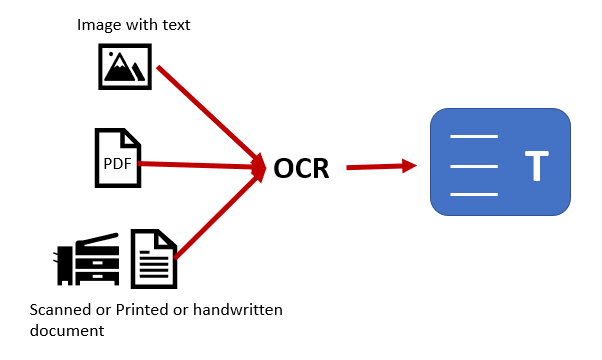It lessens the chance that papers will be misplaced or lost, and it frequently eliminates the need to manually process documents or rekey information, both of which can lead to mistakes. Additionally, it can lower the price of manual handling.
The procedure used to transform an image of text into a machine-readable text format is known as optical character recognition (OCR). Your computer will save the scan as an image file, for instance, if you scan a form or a receipt.
With AI OCR API, you can connect it to technology that can read different elements, such as all the fields on a receipt.
The words in the image file cannot be edited, searched for, or counted using a text editor. The image can be transformed into a text document with its contents saved as text data using OCR, though.
A basic OCR software engine functions by using templates it has for various typeface and text picture patterns. Character per character, the OCR program compares text images to its internal database using pattern-matching algorithms.
It is referred to be optical word recognition if the system matches the text word for word. Because there are so many different font and handwriting variations, it is impossible to capture and save every single one in the database, which places restrictions on this solution.
Intelligent character or image file recognition software To read a text like a human would, modern OCR software systems employ intelligent character recognition (ICR) technology. By utilizing machine learning software, they employ cutting-edge techniques that teach machines to behave like people.
A neural network, a type of machine learning system, examines the text on numerous levels while processing the image repeatedly. It searches for various visual characteristics including curves, lines, junctions, and loops, and then combines the findings from all these many layers of analysis to produce the final product.
ICR normally processes the photos one character at a time, although the procedure is quick and produces findings in a matter of seconds.
Intelligent word and scanned documents recognition Similar to ICR, intelligent word recognition systems process entire word pictures rather than first converting them into characters.
Optical mark recognition A document’s logos, watermarks, and other text symbols can be recognized using optical mark recognition.
Why is OCR software important? The majority of corporate workflows include information gathering from print media. Business processes include the use of printed contracts, scanned legal documents, invoicing, and paper forms.
It takes a lot of time, space, and effort to store and manage these massive amounts of paper. Although managing documents without a paper are the way to go, scanning paper documents into images present difficulties. The method calls for manual intervention and is laborious and slow.
Additionally, digitizing this document material produces graphic files that conceal the text. Word processing software cannot process text in photos the same way it does text documents. By transforming text photos into text data that can be evaluated by other business tools, OCR technology finds a solution to the issue. The data can then be used to perform analytics, declutter operations, automate procedures, and boost efficiency.
How does OCR software work? To convert the scanned image into text, OCR examines the patterns of light and dark that make up the letters and numerals. Rules help OCR systems match what it sees in the image to the correct letters or numbers since they need to recognize characters in different typefaces.
Some contemporary free OCR software can even recognize people’s handwriting and image format, in contrast to the early OCR scanner that was only intended to work with a single typeface that was generated specifically for the purpose. Intelligent character recognition is the name of this technology (ICR).
It’s crucial to scan the paper and social media images as clearly as you can for OCR-free software to function at its best. Errors may be caused by blurred text or markings on the copy.
OCR software reads the text character by character, but the results appear instantly. There are options for checking for errors throughout the process or at the end, and some programs even have automatic error detection.
The steps listed below are used by the OCR system or engine to operate:
Image acquisition Documents are read by a scanner, which turns them into binary data. The light regions of the scanned image files are categorized as backgrounds by the OCR program, while the dark areas are as text.
Preprocessing To make the image ready for reading, the OCR program first purges it and fixes any flaws. Some of its cleaning methods include:
-Fixing alignment problems during the scan may require deskewing or tilting the scanned paper significantly.
-Extracted text picture edges should be smoothed and digital image spots should be removed.
-Tidying up the image’s boxes and lines.
-OCR technology for multilingual script recognition.
Extract Text recognition Pattern matching and feature extractions are the two primary OCR algorithms or computer processes used by OCR software for text recognition.
Pattern matching A character picture, or glyph, is isolated throughout the pattern-matching process and compared to a previously recorded glyph. Only when the input glyph’s font and scale are identical to that of the stored glyph will pattern recognition be effective.
The two primary types of OCR algorithms or software processes that an OCR program uses for text recognition are termed pattern matching and feature extraction. This method performs effectively with scanned images of documents that have been typed in a recognized font.
Feature extraction Through the process of feature extraction, the glyphs are divided into features like lines, closed loops, line direction, and line junctions. The best match or the closest neighbor among its numerous stored glyphs is then found using these features.
What benefits does OCR software provide? Since the late 1920s, there has been some basic OCR technology. Since those early days, it has advanced significantly, and it can now quickly and accurately transform even extremely complicated documents. When documents are converted from their original format to the new format, all formatting is faithfully copied, and they retain their original appearance.
6 key ways OCR software is helping businesses today 1. Automate workflows Businesses that use a lot of paper might save time and become more productive by batch scanning. To make them easier to find, files can be scanned and indexed. Invoices and other documents that call for action can be incorporated into automated workflows that guide them through the necessary approval and payment procedures.
2. Turn read-only files into editable text OCR software extracts read-only text from documents, like PDFs, allowing you to edit, reuse, and search for it.
3. Create audible files Making lengthy or complicated documents into an audio file will allow you to read them faster. As a result, you can be more productive by listening to the document during your commute or at the gym. This makes written material accessible to those who are blind or have other visual impairments.
4. Translate foreign languages Some OCR software programs can translate documents from more than 180 different languages.
5. Manage forms and questionnaires It used to take countless hours of time and effort to manage forms and questionnaires that were manually completed. With OCR software, you can quickly scan documents, converting the data into the searchable text to quickly gain insights or take action.
6. Achieve faster, more accurate data entry You may automate data entry and eliminate the need to rekey information into systems by employing OCR software and digitizing data sources. By doing this, you can save time and get rid of mistakes that may have crept in during manual data entry.
What is OCR used for? The following are a few typical OCR usage scenarios across different industries:
Banking OCR is used by the banking sector to process and validate papers for loan applications, check deposits, and other financial activities. Through this verification, fraud prevention and transaction security have both increased.
For instance, BlueVine, a provider of financial technology, finances small and medium-sized businesses. It created a system for US small companies to easily acquire Paycheck Protection Program (PPP) loans as part of the COVID-19 relief stimulus package by using Amazon Textract, a cloud-based OCR service.
Tens of thousands of PPP forms were automatically processed and analyzed by Amazon Textract each day so that BlueVine could aid thousands of businesses in obtaining funding and protect over 400,000 jobs.
Healthcare OCR is used in the healthcare sector to process patient records, including records of procedures, examinations, hospital stays, and insurance payments. OCR assists in streamlining processes and reducing manual labor in hospitals while maintaining the accuracy of records.
For instance, the nib Group gets hundreds of medical claims each day and offers health and medical insurance to more than 1 million Australians. Customers can use the nib mobile app to upload photographs of their medical bills. These photos are automatically processed by Amazon Textract, allowing the business to approve claims considerably more quickly.
Logistics OCR is used by logistics organizations to better effectively track package labels, invoices, receipts, and other documents. For instance, the Foresight Group automates SAP invoice processing using Amazon Textract.
Due to the need to manually enter the data in several accounting systems, Foresight workers’ work on these business documents was time-consuming and prone to mistakes. Foresight software can read characters more precisely across a wide range of layouts according to Amazon Textract, which boosts organizational effectiveness.
Conclusion The OCR software is made up of a lot of different features that make it easy to scan documents, photos, and receipts. There are functions such as scanning in batches, scanning straight from your computer, and scanning in black and white or color. The software also has a neat little feature called “smart cropping.” This feature makes it easier to scan any document with the edges of the document being scanned. This can be helpful if you are scanning a large document that has a lot of white space on the left and right sides. Another neat feature is the “keyboard shortcut” which allows you to scan a document faster by pressing certain keys. Explore the Top 10 OCR Software
FAQ What is optical character recognition? Ocr software uses a computer and a scanner to read the text of a scanned document, convert it to machine-encoded text, and then store it for future retrieval.
What is the difference between an OCR and a translator? An OCR (optical character recognition) program scans images of text, and then converts that information into digital text. The translation is done by a human, who reads the translated text and translates it into other languages.
What is the process of OCR? The process of OCR is to convert an image or scanned document into text.
.




